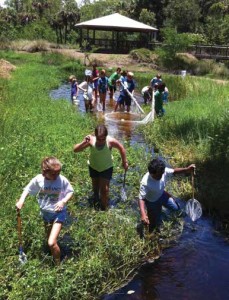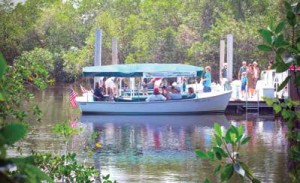Education at the Conservancy
 by Nick Penniman
by Nick Penniman
We always talk about choices, about how to make southwest Florida a better place. And we don’t talk about the abstract, but rather what concrete steps can we take together, what tangible things we can do.” The passion is evident as Nicki Dardinger, Director of Education for the Conservancy of Southwest Florida, talks about school programs which last year touched the lives of 11,000 kids from pre-K to 12th grade.
The program, in coordination with the Collier County School District, stretched back to the early 1970s when the Conservancy merged with the Big Cypress Nature Center with its robust curriculum reaching deep into the schools. Much of the emphasis was on wildlife – snakes and birds, turtles and panthers – some of which could be brought into the schools. Conservancy leadership at the time realized how important it was to move beyond its Port Royal base of support, and involving young families was the perfect answer. Since then, environmental education has remained a mainstay of county schools.
But the best way for kids to appreciate the natural world is through the Conservancy’s summer programs – one of which is illustrated here.
Kids are given a hands-on experience seining for aquatic creatures as they wade through the Conservancy’s filter marsh (designed to clean the water before it goes into the Gordon River) as they learn about the micro-environment beneath their feet. It’s a tactile experience, feeling the marsh beneath their feet, a way of understanding how delicate the balance is between man and nature. More information is available at https://www. conservancy.org/our-work/education/camps.
But education doesn’t stop with kids. It goes on with programs like guided electric boat trips down the Gordon River toward Naples Bay, shown in this photograph. With five boats and over 100 captains and dock masters, all trained naturalists, visitors are given a first-hand look at how the mangrove fringe surrounding south Florida’s coast enhances and protects the environment. Last year, over 22,000 people took the boat rides. No reservations are required (except for the Sunday boat-and-brunch).
 While water is important to southwest Florida’s environmental health, another piece of the education program is a walk through multiple ecosystems on the Conservancy’s twenty-one acre campus. South Florida’s elevation change from Lake Okeechobee south is only eleven feet, but within that narrow decline lie three separate major ecosystems – coastal and inshore marine environment, freshwater wetlands, and upland forests – all on display and accessible within the Conservancy’s grounds.
While water is important to southwest Florida’s environmental health, another piece of the education program is a walk through multiple ecosystems on the Conservancy’s twenty-one acre campus. South Florida’s elevation change from Lake Okeechobee south is only eleven feet, but within that narrow decline lie three separate major ecosystems – coastal and inshore marine environment, freshwater wetlands, and upland forests – all on display and accessible within the Conservancy’s grounds.
“Daily trail walks, guided by trained volunteers, are a great way to see a small piece of the ecosystem,” says Dardinger. “You move quickly, with only a small change in elevation, from hardwood hammock to slash pine forest. It’s a clear transition – easy to see. And it’s only a few yards from the mangroves which thrive in the estuary. All our education programs depend upon the expertise of Conservancy volunteers, carefully trained to provide a captivating experience to visitors. And volunteers are always needed.” More information can be found at https://www.conservancy.org/get-involved/volunteer.
Finally, Dardinger, whose background is in animal biology, expresses her vision. “We need to keep being fresh. As we look at the visitor experience for adults and families, we always have our eye on the next step. And for the school and summer programs, we want to make it more relevant, because the bottom line is maybe some of these kids will look at environmental science not as a dull subject to be avoided, but as a dynamic opportunity for a future career.”

Leave a Reply
Want to join the discussion?Feel free to contribute!